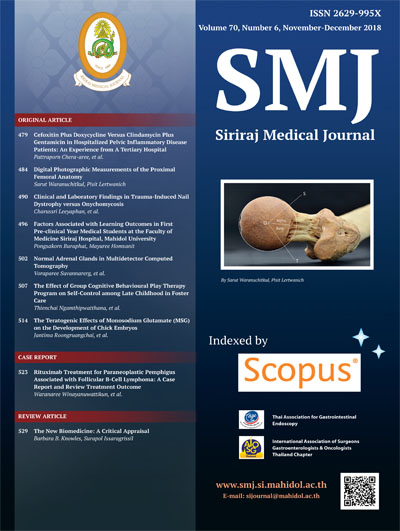Factors Associated with Learning Outcomes in First Pre-clinical Year Medical Students at the Faculty of Medicine Siriraj Hospital, Mahidol University
Keywords:
Learning outcomes; learning behavior; electronic-lecture system; e-lecture; medical education; medical studentAbstract
Objective: Electronic learning system (e-lecture) has been developed and used as a tool to assist students’ learning. Usage of e-lecture and learning behaviors were evaluated for their associations with learning outcomes.
Methods: This questionnaire-based, cross-sectional study enrolled 107 first pre-clinical year medical students at the Faculty of Medicine Siriraj Hospital, Mahidol University, Thailand. Information on learning outcomes of biomedical subjects and learning behavior including e-lecture use, self-study time, skipping class and inattention were collected. Mann-Whitney U test and logistic regression were used for statistical analysis.
Results: Compared to students who earned average biomedical grades of >3.0, students who earned average grades ≤3.0 significantly used more e-lecture (median, IQR 63.81, 49.17-70.03 and 31.08, 11.29-51.49, respectively, p =0.001), had more inattention time during lectures (median, IQR, 22.13, 14.94-31.19, and 13.1, 8.05-20.30, respectively, p=0.008), and spent less time for self-study and review of lessons (median, IQR 102.00, 68.00-176.50, and 147.50, 106.25-246.00, respectively, p=0.04). For each one hour increase in e-lecture usage, the chance of earning an average biomedical grade of >3.0 was decreased by 4%. Positive correlations were found between e-lecture usage with skipping class and with inattention during lecture (coefficients = 0.31 and 0.37, with p=0.001 and p<0.001, respectively). Time spent for self-study and review of lessons negatively correlated with inattention during lectures (coefficient =-0.28, p=0.003).
Conclusion: E-lecture may be misused by students who have poor learning behaviors as a substitute for in-class lectures. Time voluntarily spent in e-lecture may be an indicator for students who need educational guidance and/or counseling.
Downloads
Published
How to Cite
Issue
Section
License
Authors who publish with this journal agree to the following conditions:
Copyright Transfer
In submitting a manuscript, the authors acknowledge that the work will become the copyrighted property of Siriraj Medical Journal upon publication.
License
Articles are licensed under a Creative Commons Attribution-NonCommercial-NoDerivatives 4.0 International License (CC BY-NC-ND 4.0). This license allows for the sharing of the work for non-commercial purposes with proper attribution to the authors and the journal. However, it does not permit modifications or the creation of derivative works.
Sharing and Access
Authors are encouraged to share their article on their personal or institutional websites and through other non-commercial platforms. Doing so can increase readership and citations.











